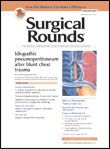Why Surgeons Should Fess Up to Operative Errors
For most mistakes, it is best to apply the "ABC" rule: acknowledge the error and accept responsibility, be gentle with yourself, and correct it, make amends, and move on. But if the blunder occurs in the surgical suite, it is not that simple.

For most mistakes, it is best to apply the “ABC” rule: acknowledge the error and accept responsibility, be gentle with yourself, and correct it, make amends, and move on. But if the blunder occurs in the surgical suite, it is not that simple.
The April 2014 issue of The Surgeon contained companion articles on this topic written by authors in the United States and the United Kingdom. Universally, advanced healthcare systems require the disclosure of surgical errors to affected patients as a key element of transparency, as it builds patient trust and galvanizes a culture of safety while meeting surgeons’ ethical obligations.
But precisely how surgeons and the facilities in which they work address errors varies, and oftentimes, disclosure fails to work its way into practice. The key drivers that discourage the disclosure of surgical errors include liability issues, possible effects on the surgeon’s or facility’s reputation, and potential media involvement. Since medical schools generally skip over how to deal with errors and what to disclose, many surgeons face these emotionally charged issues with little training.
The US article described some recently developed institutional programs, some of which disclose errors and apologize for them, while others augment the process with a compensation offer. The authors mentioned one particular US Department of Veterans Administration (VA) disclosure, apology, and offer program that moved their liability payments from the top quartile to the bottom quartile when compared to similar institutions. They also depicted a similar program at the University of Michigan that improved the system’s malpractice profile. In addition, they discussed balancing facts with feelings and conducting a series of discussions with patients, rather than hosting a single meeting.
In the UK piece, George G. Youngston indicated that the magnitude of each surgical error dictates the appropriate response and the manner in which an apology is delivered. Although some errors cause no harm, they are mistakes nonetheless. Taking a what, why, who, and when approach, Youngston detailed the differences between diagnostic and procedural errors and emphasized that failure to disclose surgical mistakes leads to higher malpractice costs and lower care quality. Despite the fact that the US and UK systems differ considerably, Yougston’s review of legal claims filed in the UK is informative for surgeons in both countries.
Both articles pointed out that expression of contrition is not necessarily acceptance of liability. Thus, carefully worded empathetic apologies are critical whenever medical errors occur.
